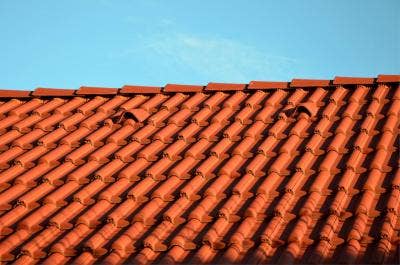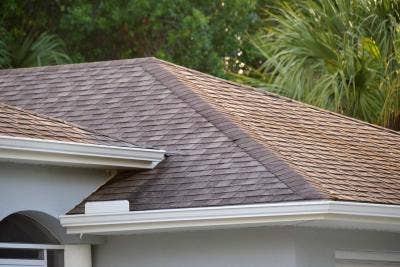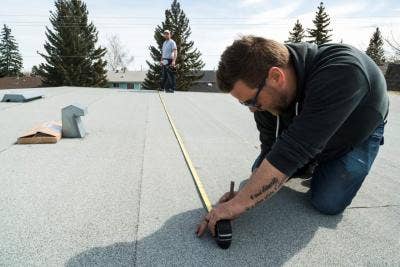Fascia and Soffit – Keeping everything neat and tidy
Like any other roofing item, soffits and fascias also degrade over time which might need replacement. However, if you want to update your home's exterior, fascia and soffit replacement, it adds value to your property. The soffit is aesthetically pleasing and has the practical purpose of keeping elements such as rain, snow, birds and insects out of the attic. On the other hand, rightly-installed fascia protects roof edges from water damage.
Table of Contents
- What Are Soffit and Fascia Boards?
- Why Replace Soffit and Fascias?
- Soffit and Fascia Replacement Cost
- Safety Considerations
- Step-by-step Guide for Soffit and Fascias Replacement
- How To Maintain Your Fascias, Soffits and Guttering
- Conclusion
- Frequently Asked Questions (FAQ)
When done correctly, soffits and fascias add an extra layer of protection against moisture buildup that leads to wood rot or even termites in some cases—ultimately saving money on costly repairs down the road. That said, fascia and soffit replacement can sometimes be challenging and involve huge costs. Therefore we've compiled this comprehensive guide for homeowners who want to do fascia and soffit replacement alone.

What Are Soffit and Fascia Boards?
Often referred to as the 'roofline', the fascia is the point where the roof meets the house's outer walls. In the past, the roofline has typically been made up of wooden board or sheet metal, but in recent years there has been an increase in plastic fascias as they require much less maintenance.
The fascia provides an excellent aesthetic finish to the roofline; it acts as an extra barrier against weather conditions and is used to support the guttering. Although many people refer to the roofline as the 'fascia', it is made up of several different components:
Fascia
The fascia board is the long, straight board that runs along the roof's lower edge. It is fixed directly to the roof trusses and usually supports the bottom row of tiles, and carries the guttering.
Bargeboard
The bargeboard is the board fitted to the house's gable end. The bargeboard significantly contributes to a property's aesthetics, and various shapes and styles can be used to create a striking finish.
Soffit
The soffit board is the length of the committee tucked away underneath the fascia. This piece of board is most visible from street level, looking up. The soffit can be ventilated to allow airflow into the roof area, although adding ventilation to the top of the fascia board is becoming more common. Either way, ventilation is essential to prevent condensation in the roof, which could lead to timber decay.
Box end
The box end is the piece which connects the fascia, soffit, and bargeboard at the gable end of a house. It must consider the various angles from each connecting board to create a clean finish to each corner.
Why Replace Soffit and Fascias?
You may need to replace soffits and fascias in your home for several reasons. Here are some of the most common reasons:
- Water damage: Over time, fascias and soffits can become damaged by water, especially if they're made from wood. Water damage can lead to rot, which weakens the structure of the roofline and can cause further damage.
- Insect infestation: Wood fascias and soffits are also vulnerable to insect infestations, such as termites or carpenter ants. This can lead to significant damage if left unchecked.
- Aesthetics: Old or worn fascias and soffits can detract from the appearance of your home. Fascia and soffit replacement can give your home a fresh and updated look.
- Maintenance: If your fascias and soffits are constantly in need of repair, it may be more cost-effective to replace them entirely.
- Energy efficiency: Newer soffit and fascia materials can provide better insulation, which can help to reduce energy costs and keep your home more comfortable.
Soffit and Fascia Replacement Cost
The size of your house and roofing project determines the cost of replacing your soffits and fascias. However, replacing them typically minimises a minor portion of the overall cost, and scaffolding takes up high charges on average.
Fascia and soffit replacement is necessary home improvement, but it can come with a hefty price tag. The average cost to replace fascias and gutters is around £100 per metre, which adds up quickly for larger projects.
It's important to research who you hire for the job as some contractors might charge more than others. This can add additional costs if you're not careful. To get the best value, compare prices before deciding on a contractor.
Safety Considerations
Before replacing the soffit and fascia boards, remember that your priority should always be safety.
- Use the right safety gear, such as gloves, roofing boots, and coveralls, when working on a roofing project.
- Also, it's crucial to use a robust ladder and enlist the assistance of a friend to hold it steady.
Step-by-step Guide for Soffit and Fascias Replacement
Fascia and Soffit replacement is integral to maintaining a home's exterior. They are known to protect the roofline and prevent water damage; ensuring they're in good condition is essential. Here's a step-by-step guide to replacing soffit and fascia:
Materials Needed:
- Soffit panels
- Fascia boards
- J-channel trim
- Aluminium drip edge
- Nails
- Screws
- Caulk
Tools Required:
- Measuring tape
- Circular saw
- Miter saw
- Drill
- Hammer
- Level
- Ladder
Installation
Preparation
- If replacing the fascia boards on an existing property, you should start by removing the bottom two rows of tiles.
- Then remove old fascias, soffits and bargeboards to prevent any remaining moisture from rotting the supporting timber. If parts of the original boards are left in place, ensure that rotten timber is cut out and replaced with treated wood.
- Inspect the felt or underlay between the rafters and replace it as necessary with a deemed or eaves protector.
- Provide adequate support at the wall for the soffit by extending a noggin from the wall, fixing a batten to the wall, or using the rafters as support.
- The soffit board can be fixed directly to the noggin or batten with plains. For a neat finish, J-Trim can be used in single or two-part form to hold and give a clean finish to the inside edge of the soffit at the wall.
- If you are using a cladding profile or hollow soffit, they can be used in short lengths from the wall to the fascia.
- The gable end can be finished with the soffit running down to the box end or terminated at an angle of 45 degrees to the corner of the wall, and an H-Trim is used to integrate with the soffit forming the base of the gable box.
- Ventilation is provided by purpose-made slotted soffit boards or using over-fascia ventilation.
Fixing the Fascia
- The depth of the fascia should be chosen so that the top edge of the fascia does not bear the weight of the tiles if 10mm or less in thickness.
- Nail the first length of the fascia into position, starting precisely in line with the centreline of the corner rafter, then at no more than 600mm centres into the ends of the rafters.
- Remember that once the fascia is fitted, the guttering will follow, so it is essential to position the nails to be clear of the subsequent screw fixings. This will ensure that the screws go in without any problem and that the brackets won't suffer movement because of a protruding nail head behind them.
- Cut back the fascia leg at a 45-degree angle at the gable end.
- Cut the fascia to length to ensure that the other end meets with the centre line of a rafter.
- Nail the fascia twice into the tail of each rafter at no more than 600mm centres.
- A joiner will be required at the joint between each length of the fascia board. Pre-drill and twice pin it to either one of the left or right-hand fascia boards, ensuring a minimum of 5mm space between the board ends to allow for expansion.
- If bargeboards are not used, the fascia boards can be fixed along the front of the house with joints at rafter tails as necessary. The projecting eaves usually have a small box end cut from a single piece of the fascia board. If a separate fillet is required to cover the tilting fillet, the additional triangle can easily be integrated into the new box end. When fascia and box ends are in place, fix end caps or corner trims to both ends.
- If bargeboards are used on the project, the procedure is slightly different as the box ends must be formed as part of the process.
- Before cutting the corner trim, remember that the depth of the eaves fascia does not govern the height, but the depth of the bargeboard is critical.
- A 225mm deep bargeboard, when cut vertically at the end, must be more profound as it is not being cut at right angles.
- If the roof's pitch is 45 degrees, 225mm becomes 315mm, and 22.5 degrees, the depth required is 242mm. A tilting fillet can add approximately 50mm extra. Remember that the leg of the fascia will support the outside edge of the soffit.
How To Maintain Your Fascias, Soffits and Guttering
You can save money on fascia and soffit replacement if you maintain them. Maintaining your soffit and fascia is critical to keeping your home's roofing system in good condition. Maintaining your gutters to prevent overflow onto your soffits and fascia is also essential.
- Inspect regularly: Regular inspections can help you identify any damage or wear before it becomes a significant problem.
- Keep them clean: Cleaning your soffits and fascia at least once a year can prevent dirt and debris from accumulating on the surfaces, leading to discolouration or damage. Use a mild detergent and water, and avoid using high-pressure washers.
- Seal gaps: Seal any cracks you find with caulk or a suitable sealant to prevent pests or moisture from entering your attic.
- Maintain gutters: Regularly clean your gutters to prevent buildup and check for any damage. Repair or replace damaged gutters as soon as possible.
- Use quality materials: When installing or replacing your soffits and fascia, use quality materials that are durable and long-lasting.
Conclusion
In conclusion, fascia and soffit replacement are essential to maintaining your home's structural integrity and overall appearance. Following the simple steps outlined in this guide, you can replace these components and ensure that your roofline is well-protected from water damage and insect infestations.
Whether you're looking to update your home's look or improve its energy efficiency, replacing fascias and soffits is a wise investment that can pay off in the long run. So, don't hesitate to start your fascia and soffit replacement project today and enjoy the benefits of a well-maintained home.
FAQ
How often should fascias and soffits be replaced?
This depends on the material and condition of your existing fascias and soffits. They may need to be replaced every 10-15 years. However, it's best to address the issue promptly if you notice signs of damage or wear.
Can I replace fascias and soffits on my own?
Yes, with the right tools and materials, you can replace fascias and soffits on your own. However, it's essential to exercise caution when working at heights and to follow the steps carefully.
What materials are best for fascias and soffits?
There are many options for fascias and soffits, including uPVC, wood, aluminium, vinyl, and composite materials. Each has advantages and disadvantages, so it's best to consult a professional to determine the best material for your home.
How do I know if my fascias and soffits need to be replaced?
Signs of damage or wear, such as cracks, rot, or insect infestations, are indicators that your fascias and soffits need replacement. Additionally, if your energy bills are higher than usual or your home's appearance deteriorates, it may be time for a replacement.
Can I paint my new fascias and soffits?
Most fascia and soffit materials can be painted to match your home's exterior. However, using the appropriate paint type and following the manufacturer's instructions is essential.
Do I need to replace my gutters when replacing my fascias and soffits?
It depends on the condition of your gutters. They may not need to be replaced if they are in good condition. However, if they are damaged or worn, replace them simultaneously with your fascias and soffits to ensure proper water drainage.
Our Top Videos.


How to install a Velux Integra Electric Roof Window (5 Parts)
In this five-part guide, we take you through the full installation of a Velux GGU Centre Pivot Integra Roof Window onto an...


How to install a Duratech Centre-Pivot Pine Roof Window
Once you begin unpackaging the window, you’ll find in the box the brackets, the handle and the fixings. And there will also be some instructions...
Ideas & Advice
How-tos, tutorials and videos


How and why to use or snap a chalk line
Chalk lines are the fastest way to mark straight guidelines on flat surfaces. They are used extensively in the building and construction industry to speedily and accurately ‘draw’ straight lines between two points. Chalk lines are inexpensive tools...


Skylight Blinds: A Guide To The Different Types
Like many household product, blinds for skylight windows come in all shapes, sizes, and materials. Some are designed with a tangible purpose in mind, while others are more for show. One thing’s for sure - buying any type of skylight blind...








